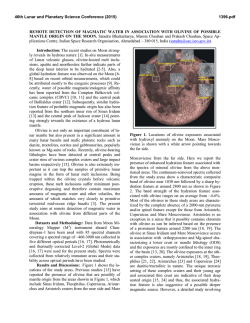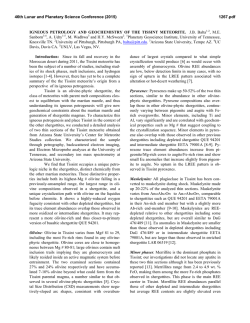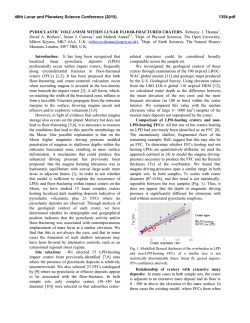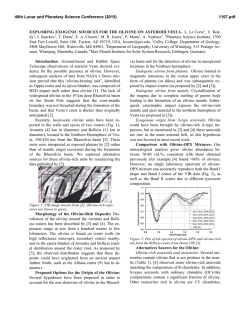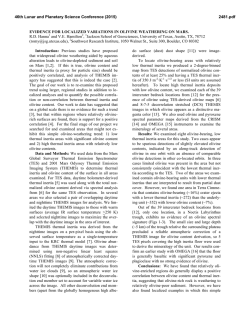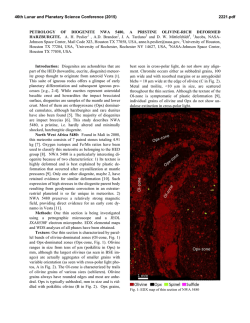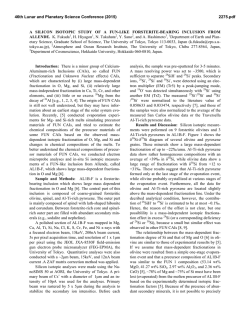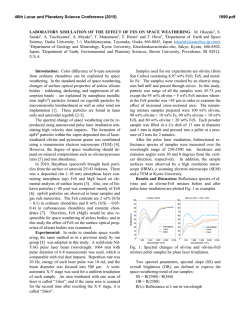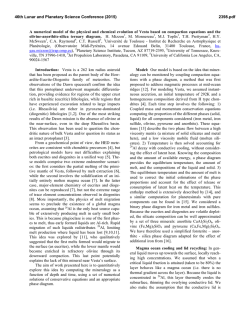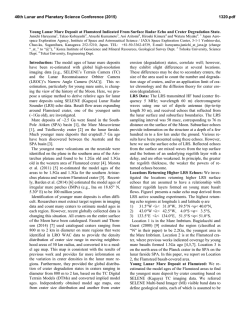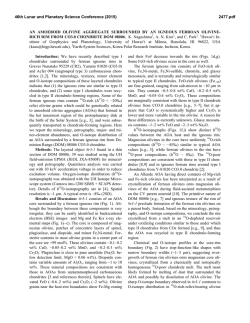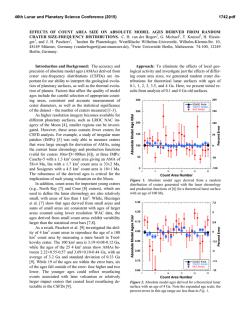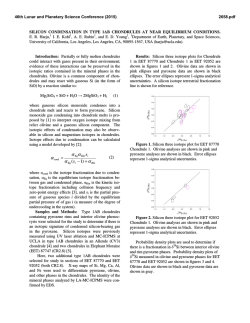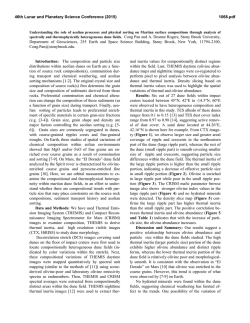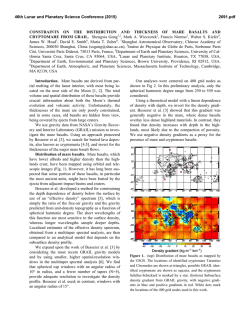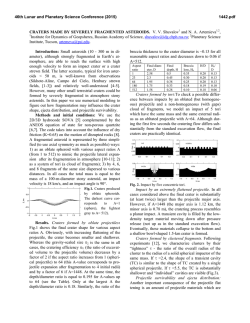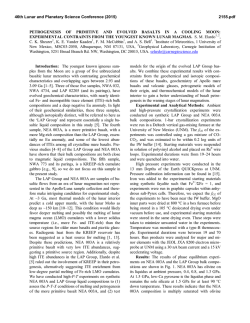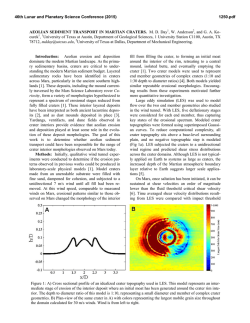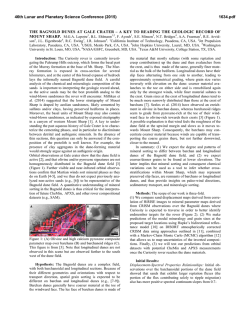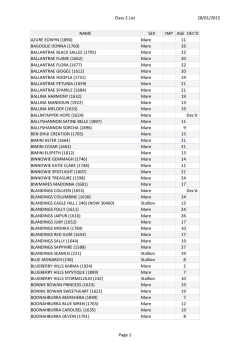
Mapping of Olivine Rich Layer in Nectaris Basalts Using Moon
46th Lunar and Planetary Science Conference (2015) 1973.pdf MAPPING OF OLIVINE RICH LAYER IN NECTRIS BASALTS USING MOON MINERALOGICAL MAPPER (M3) DATA ONBOARD CHANDRAYAAN-1. Prabhjot Kaur1, 2, Prakash Chauhan1 and A. S. Rajawat1, 1Space Applications Centre, Ahmedabad, India-380058 ([email protected]), 2Nirma University, Ahmedabad, India-382481. Introduction: Mare Nectaris is a multiring basin of 860 km diameter centered at 16º S, 34º E and located on the eastern near side of the Moon. The basin exhibit diverse geologic units, including mare basalts, dark mantle or pyroclastic deposits of volcanic origin [1, 2]. The basin is heavily influenced by the ejecta cover emplaced by the large craters such as Theophilus and Madler and encloses many dark-halo craters (DHCs) [3]. Previous studies suggested that Nectaris basin is filled by two and possibly three basalt units and is dominated by one with a high alumina (HA) composition (Iltm). Spectral profiles of the craters from Clementine data show two mineralogies- Unit Iltm may be composed of two contemporaneous mare basalt flows, both of a HA composition and a small mid-Ti unit caps the near-center of Mare Nectaris [4]. Beaumont L represents one such DHC of ~4 km (14.2º S 30.0º E) and is located southeast of Theophilus and south of Madler in the northwestern portion of the Mare Nectaris. Other unnamed DHCs are also present which lie over the distal end of Theophilus and Madler continuous ejecta blanket. These dark-haloed craters have been studied for their composition using M3 data, where Beaumont L is found to be rich in olivine and suggested to excavate olivine rich cryptomare layer hidden beneath the Theophilus and Madler ejecta [5]. Olivine is the first mineral to crystallize from mafic magma and its composition is the direct indicator of the composition and magmatic differentiation history of the source magma [6]. Olivine is identified using reflectance spectroscopy based on its characteristic overlapping absorption near 1 µm and absence of 2 µm absorption. Global distribution of olivine rich deposits was mapped using Spectral profiler data onboard SELENE which suggests that these exposures represent some of the deepest materials excavated by the basin-forming impact and are present largely in and around the rims of large lunar impact basins [7]. The mapped olivine rich sites may represent exposures of the lunar mantle or differentiated plutons resulting from secondary magmatic intrusions into the lunar crust. The aim of this study is to map the distribution of olivine rich layer that may represent compositional distinct flows present within the Nectaris basalts which have not mentioned in earlier studies. Data set and Method: We used data from Moon Mineralogical Mapper (M3) onboard Chandrayaan-1 [8]. M3 is an imaging spectrometer with spectral range 0.45 - 3.00 μm and 85 spectral bands [9]. Data imaged from 100 km orbit having spatial a resolution of ~140 m per pixel have been used for detailed mineralogical analysis. Around 350 craters were selected and investigated for their spectral properties. Band centers and band areas for 1µm and 2 µm absorption were estimated of the continuum removed spectra. Observations: The distribution of olivine-rich craters identified based on the strong 1 µm and a weak 2 µm along with BAR values less than 1.5 is shown in figure 1. The depth of excavation of the craters were calculated which is approximately 1/10th of the transient crater diameter [10]. Figure 1a shows map of Mare Nectaris with thickness labeled as inferred from the craters excavation depth. The minimum and maximum excavation depths of the olivine rich craters are used to provide lower and upper bound for the thickness of olivine rich layer unit. The olivine rich layer thus, present with a maximum thickness of around 370m and minimum of 20 m. The continuum removed reflectance spectra display strong and symmetric band I with an additional band around 1.3 µm and weak band II characteristic of olivine are shown in figure 1b. Out of all the craters investigated, Beaumont L which is a dark-haloed crater display strongest olivine signatures. Band Area Ratio (BAR) and Band I center (BC1) plot shows all data plot above the OC region which represents olivine dominance over clinopyroxenes [11]. Variation in BAR as well as BC1 values suggest variable olivine content, composition or mixing. A total of 350 craters were investigated for their mineralogy, out of which 22 craters of variable diameters were found to rich in olivine. Rest of the craters show a range of mineralogy from low-Ca to high Ca pyroxenes and mixtures of olivine and pyroxenes. Rosse crater (diameter ~12 km) with maximum excavation depth of ~ 1.01 km have excavated the basement anorthositic material and thus can be used to estimate the basalt fill thickness which is around 1.01 km [12]. The presence and distribution of anorthositic material can be seen in figure 2 which shows the Integrated Band depth (IBD) map generated by assigning red band to IBD at 1 µm, green band to IBD at 2 µm and blue to 1.508 µm albedo channels. The blue color in the map signifies presence of anorthositic material on the walls and in the ejecta surrounding the crater. Orange hue is attributable to strong 1 µm absorption 46th Lunar and Planetary Science Conference (2015) 1973.pdf Continuum Removed Reflectance because of olivine and is present mostly near the rim area. Beaumont L b Wavelength (µm) Rosse (µm) (um) I Center Band Band I Center 1.10 1.00 c a 0.90 0.00 0.50 1.00 1.50 2.00 2.50 3.00 BandBand AreaArea Ratio (BAR) Ratio Figure 1(a) Map of Mare Nectaris generated from M3 images with thickness labeled as inferred from the craters excavation depth. (b). continuum removed reflectance spectra of some of the craters represented by the same color as on map display strong band I weak band II characteristic of olivine. (c). Band Area Ratio (BAR) and Band I center (BC1) plot shows all data plot near the olivine dominance region. 2 10 km Figure 2. Integrated Band depth (IBD) where the blue color signifies weak or absence of 1 - and 2 µm absorption due to presence of anorthositic material. Conclusions: Mapping and thickness determination of the mare basalt flows is important to know the compositional heterogeneity that exists within a mare basin. This allows the evolution of the mare source region to be investigated and cause of the formation of compositionally distinct lava flows. This study has led to the identification of crater populations which have excavated material from compositionally distinct lava flows. The mapped olivine rich layers may represent material of the lunar mantle and distributed within Nectaris basalts during its formation or differentiated plutons resulting from secondary magmatic intrusions into the lunar crust. References: [1] Whitford-Stark (1981) Icarus, 48, 393–427. [2] Wilhelms D. E. and McCauley, J. F. (1971) Miscellaneous Geology Map, 1-604. [3] Hawke B. R. et al. (1997) LPSC XXVIII, 529-530. [4] Kramer G. Y. et al. (2008) JGR, 113, E0102. [5] Kaur P. et al., In communication with Planet. Space Sci. [6] Basaltic Volcanism Study Project (BSVP) (1981) Basaltic Volcanism on the Terrestrial Planets. [7] Yamamoto S. et al. (2010) Nat. Geosci., 3, 533–536. [8] Goswami J. N. and Annadurai M. (2009) Curr. Sci., 96, 4, 486-491. [9] Pieters C.M. et al. (2009) Curr. Sci., 96, 4, 500505. [10] Melosh H. J. (1989) Impact Cratering: A Geologic Process, 245. [11] Gaffey M. J. et al., (2002) Mineralogy of asteroids, 183–204. [12] Heather D. J. and Dunkin S. K. (2002) Planet. Space Sci. 50, 1299– 1309.
© Copyright 2026
